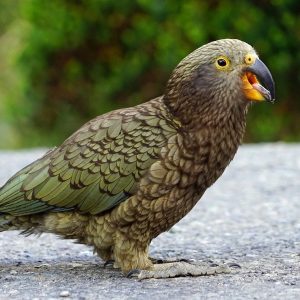
Much has been written about the need to help threatened bird species overcome the disruption of their patterns. Some birds have lived near extinction while others have gone extinct in the wild. Birds have instinctively grown accustomed to a set of “rules” that help them to exist and to mate effectively. When habitats and conditions become disrupted, they generally begin to procreate less leading to their eventual reduction of number. As many factors contribute to the reduction of birds, including illegal trade, the introduction of predatory creatures, and habitat decimation, it is largely up to caring humans to help birds overcome their surroundings and survive – if that is possible. But surprisingly, the Kea parrot may have re-adapted in the past, and if so, it may be able to do so again.
Kea Parrots Look for a Place to Chill
A recent study by five researchers for the University of Otago (New Zealand), Stockholm University (Sweden), along with the Centre for Palaeogenetics (Sweden) and the Swedish Museum of Natural History have suggested that the Kea – “The world’s only alpine parrot” – may have moved itself to the cooler alpine regions to avoid human interaction. In times past, the Kea was thought to be a nuisance in that they were alleged to actively attack and kill farmers’ sheep. Because of this unwanted and supposed behavior, the Kea species were sentenced to reduction by farmers and communities seeking to preserve their farms. Over time, this practice was eliminated by the New Zealand Department of Conservation. With a discovered mass eradication of birds leaving only a small population to exist, necessary steps of protection were implemented. Currently, there is thought to be around 3000-7000 Kea parrots left in the wild.
 The study was undertaken in a concern for approaching climate warming and how it could impact the alpine-adapted Kea in time. The availability of cold regions in this area is limited and provides little in the way of what might be acceptable relocation. To understand how the Kea might be impacted by a warmer climate, the study attempted to evaluate the birds’ past adaptation to a cooler habitat, and what evolutionary traits took them there. The thought is that the Kea simply adapted to the alpine region to avoid a human population bent on destroying them. And if that is so, perhaps a possible warming trend might be one that the Kea could evolutionarily overcome.
The study was undertaken in a concern for approaching climate warming and how it could impact the alpine-adapted Kea in time. The availability of cold regions in this area is limited and provides little in the way of what might be acceptable relocation. To understand how the Kea might be impacted by a warmer climate, the study attempted to evaluate the birds’ past adaptation to a cooler habitat, and what evolutionary traits took them there. The thought is that the Kea simply adapted to the alpine region to avoid a human population bent on destroying them. And if that is so, perhaps a possible warming trend might be one that the Kea could evolutionarily overcome.
In the study, the Kea, and their sister species, the forest-dwelling kākā, were found to be genetically similar. In short, there were not any discovered genomic differences that would identify why the Kea prefer the alpine to survive and the Kākā parrots do not. Instead, the Kea was found to have adapted to the cooler regions in much the same way the Kākā display similar adaptive responses to their lower-lying forest areas. If the alpine regions become warmer, it is possible the Kea might return to the forest.
The Kea is an intelligent creature. Large, mostly green in color, and with the ability to create sounds, it is a beautiful bird. A Kea parrot cannot be owned as their IUCN conservation and protection status doesn’t allow for it. In 2017, a Kea Database was created to record Kea observations allowing for monitoring and evaluation of habits. In this way, better information could be further gleaned to help the declining Kea to gain better reproductive traction. It is known that the mortality rate is significantly high among first-year Kea young. The Kea adult can age to around 20 years.
We sincerely hope that more productive information can be discovered to help the Kea regain their place in the world, alpine-located or not.
